ACC1125 Report: Stakeholder Engagement of M&S and Sainsbury
VerifiedAdded on 2022/09/10
|17
|4100
|29
Report
AI Summary
This report examines the stakeholder engagement strategies of Marks & Spencer (M&S) and Sainsbury, two major players in the UK retail industry, within the framework of stakeholder theory. The report begins with an executive summary and table of contents, followed by an introduction that establishes the context of corporate responsibility and sustainability in relation to stakeholder demands. It delves into stakeholder theory, defining stakeholders and exploring their classification (primary, secondary, internal, external, connected) and attributes (power, urgency, legitimacy). The report then analyzes the stakeholder engagement practices of both M&S and Sainsbury, covering their customer relations, employee interactions, supplier management, and community involvement. An evaluation is conducted to determine which company demonstrates more effective stakeholder engagement and corporate responsibility. The analysis includes stakeholder mapping, Mendelow’s Matrix, and consideration of the merits and demerits of stakeholder engagement. The report concludes with recommendations for M&S, emphasizing the need for enhanced social and community engagement. References are also included.
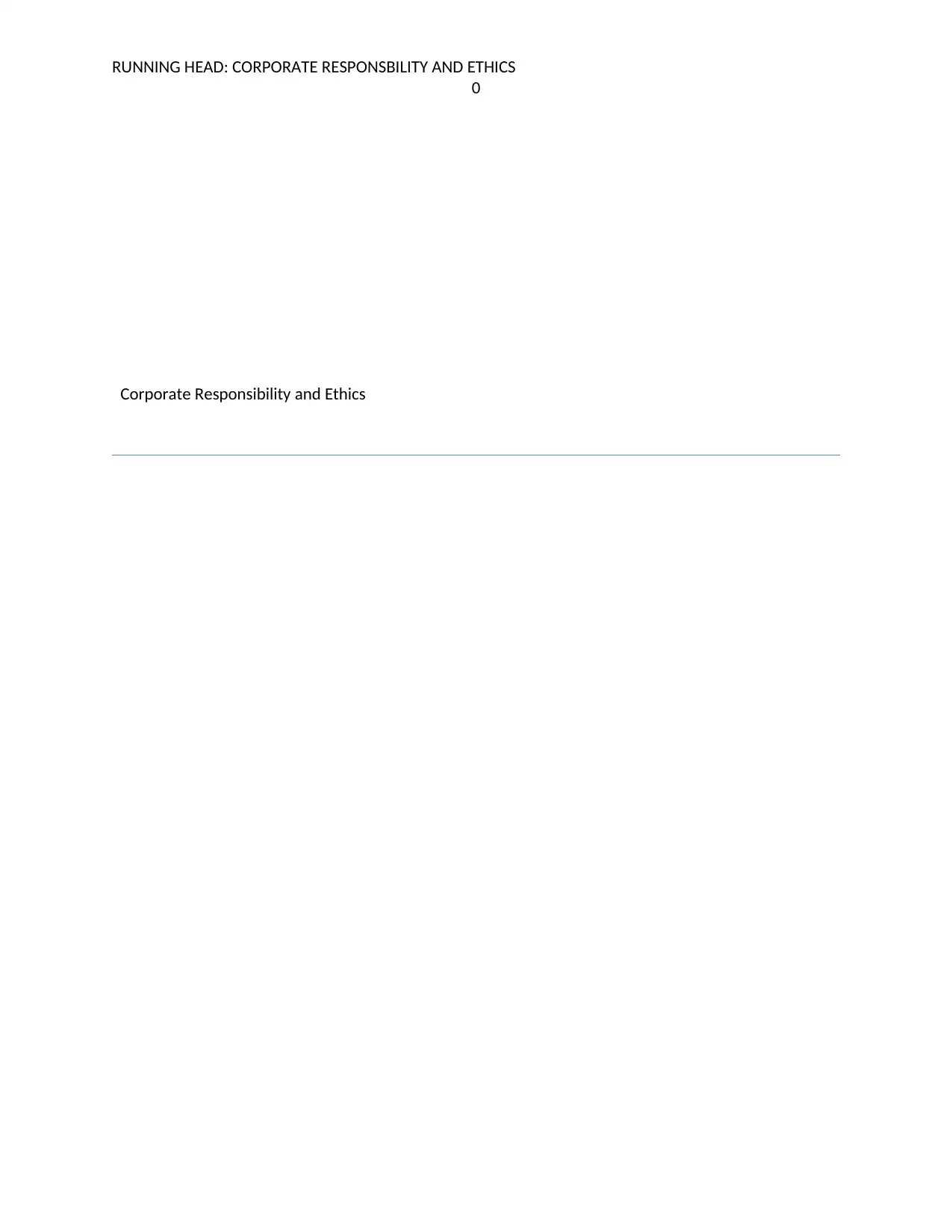
RUNNING HEAD: CORPORATE RESPONSBILITY AND ETHICS
0
Corporate Responsibility and Ethics
0
Corporate Responsibility and Ethics
Paraphrase This Document
Need a fresh take? Get an instant paraphrase of this document with our AI Paraphraser
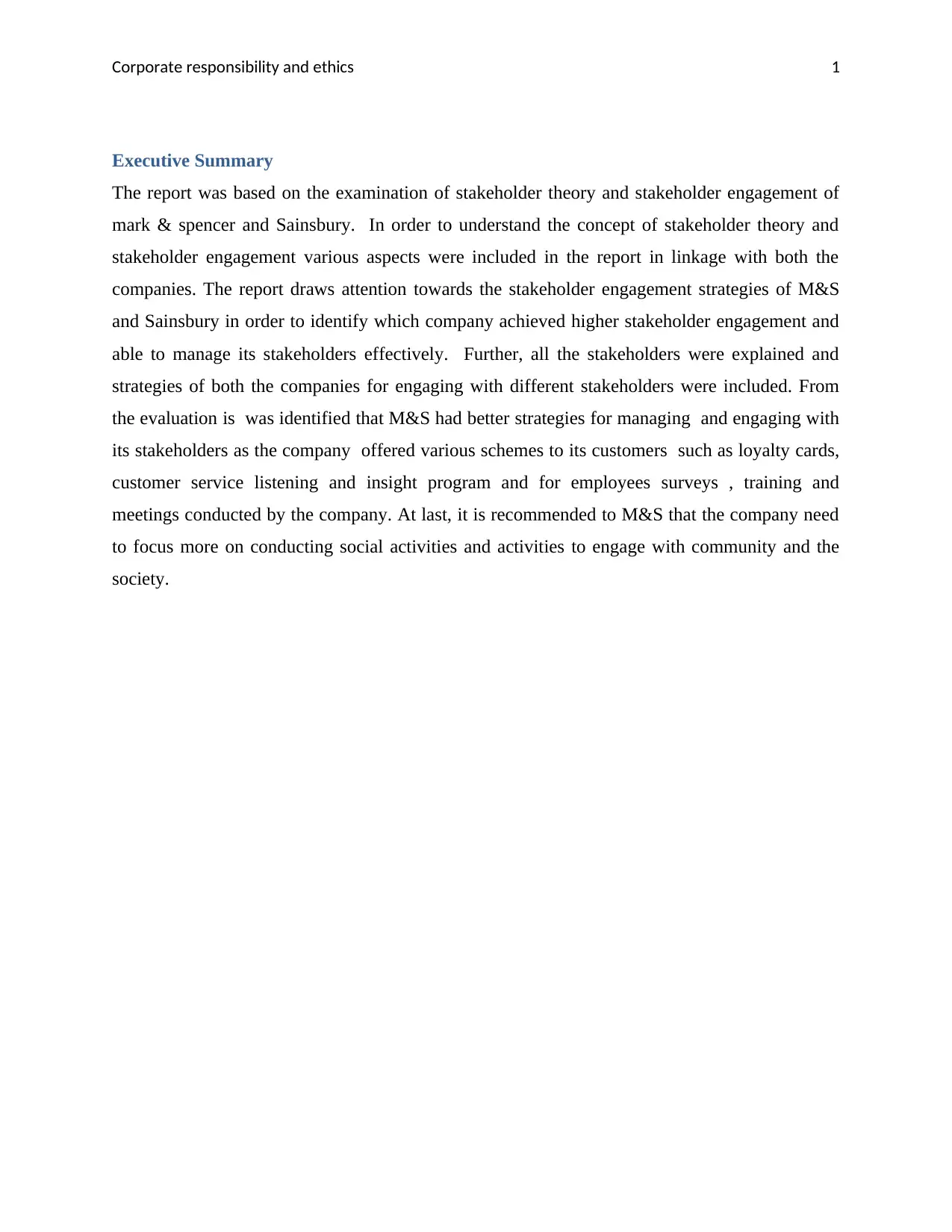
Corporate responsibility and ethics 1
Executive Summary
The report was based on the examination of stakeholder theory and stakeholder engagement of
mark & spencer and Sainsbury. In order to understand the concept of stakeholder theory and
stakeholder engagement various aspects were included in the report in linkage with both the
companies. The report draws attention towards the stakeholder engagement strategies of M&S
and Sainsbury in order to identify which company achieved higher stakeholder engagement and
able to manage its stakeholders effectively. Further, all the stakeholders were explained and
strategies of both the companies for engaging with different stakeholders were included. From
the evaluation is was identified that M&S had better strategies for managing and engaging with
its stakeholders as the company offered various schemes to its customers such as loyalty cards,
customer service listening and insight program and for employees surveys , training and
meetings conducted by the company. At last, it is recommended to M&S that the company need
to focus more on conducting social activities and activities to engage with community and the
society.
Executive Summary
The report was based on the examination of stakeholder theory and stakeholder engagement of
mark & spencer and Sainsbury. In order to understand the concept of stakeholder theory and
stakeholder engagement various aspects were included in the report in linkage with both the
companies. The report draws attention towards the stakeholder engagement strategies of M&S
and Sainsbury in order to identify which company achieved higher stakeholder engagement and
able to manage its stakeholders effectively. Further, all the stakeholders were explained and
strategies of both the companies for engaging with different stakeholders were included. From
the evaluation is was identified that M&S had better strategies for managing and engaging with
its stakeholders as the company offered various schemes to its customers such as loyalty cards,
customer service listening and insight program and for employees surveys , training and
meetings conducted by the company. At last, it is recommended to M&S that the company need
to focus more on conducting social activities and activities to engage with community and the
society.
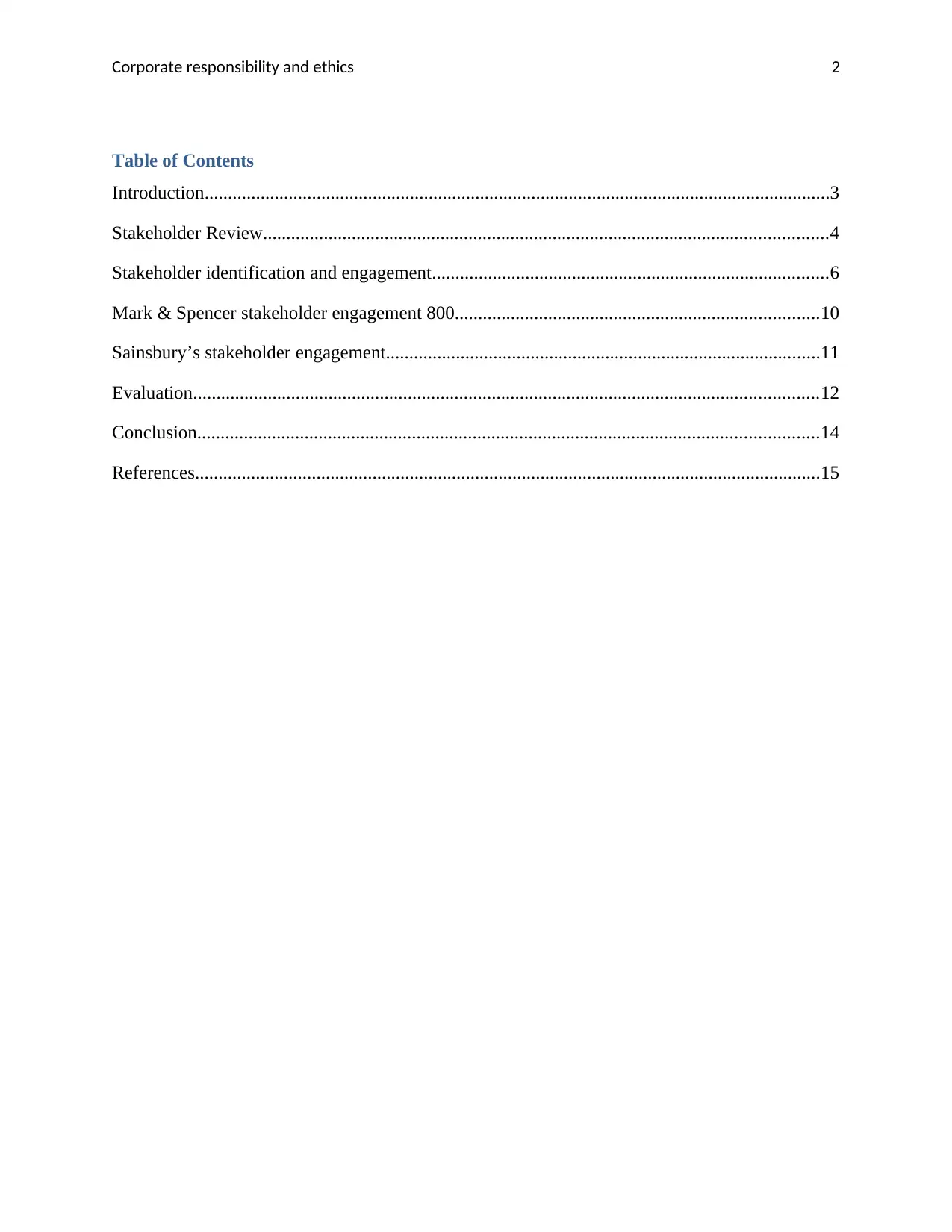
Corporate responsibility and ethics 2
Table of Contents
Introduction......................................................................................................................................3
Stakeholder Review.........................................................................................................................4
Stakeholder identification and engagement.....................................................................................6
Mark & Spencer stakeholder engagement 800..............................................................................10
Sainsbury’s stakeholder engagement.............................................................................................11
Evaluation......................................................................................................................................12
Conclusion.....................................................................................................................................14
References......................................................................................................................................15
Table of Contents
Introduction......................................................................................................................................3
Stakeholder Review.........................................................................................................................4
Stakeholder identification and engagement.....................................................................................6
Mark & Spencer stakeholder engagement 800..............................................................................10
Sainsbury’s stakeholder engagement.............................................................................................11
Evaluation......................................................................................................................................12
Conclusion.....................................................................................................................................14
References......................................................................................................................................15
⊘ This is a preview!⊘
Do you want full access?
Subscribe today to unlock all pages.

Trusted by 1+ million students worldwide
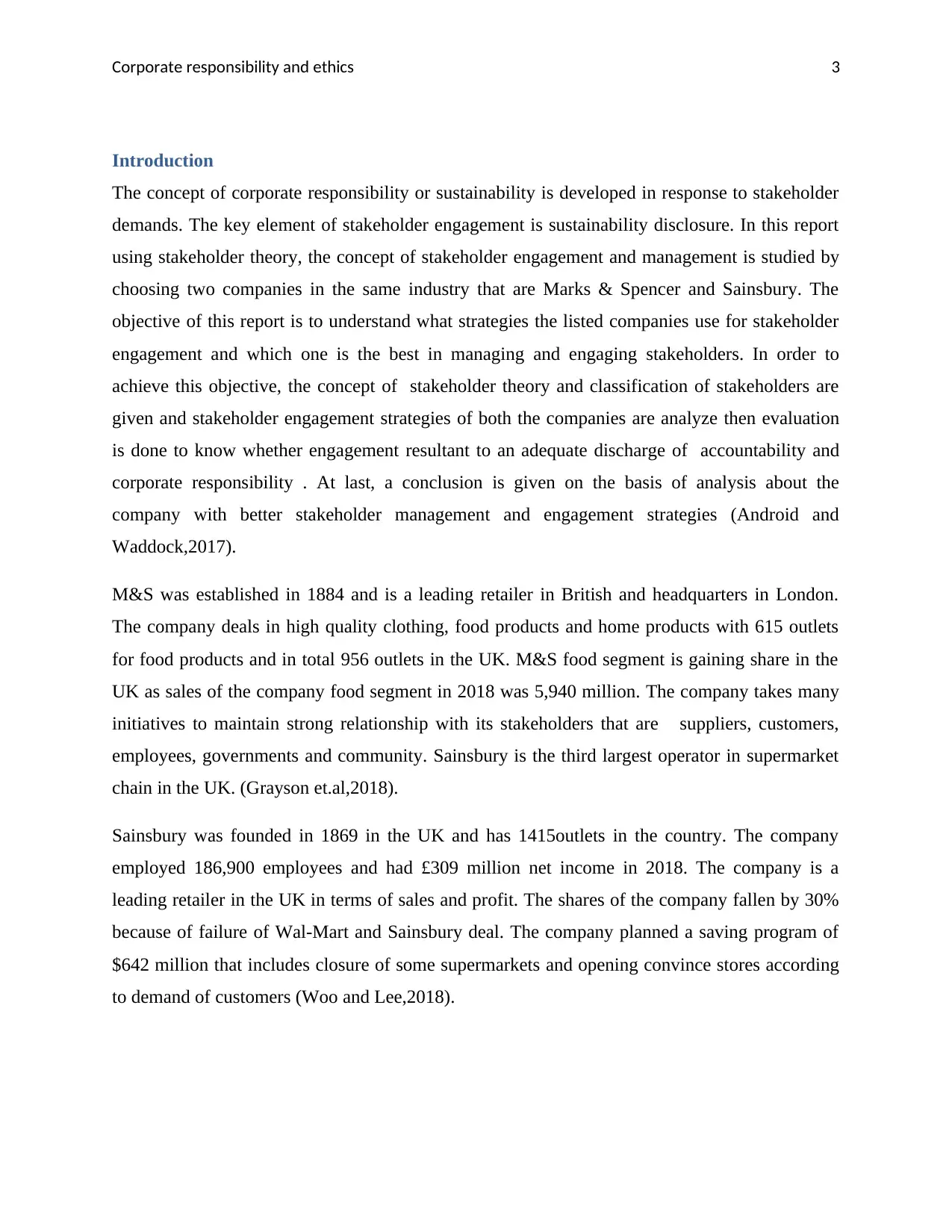
Corporate responsibility and ethics 3
Introduction
The concept of corporate responsibility or sustainability is developed in response to stakeholder
demands. The key element of stakeholder engagement is sustainability disclosure. In this report
using stakeholder theory, the concept of stakeholder engagement and management is studied by
choosing two companies in the same industry that are Marks & Spencer and Sainsbury. The
objective of this report is to understand what strategies the listed companies use for stakeholder
engagement and which one is the best in managing and engaging stakeholders. In order to
achieve this objective, the concept of stakeholder theory and classification of stakeholders are
given and stakeholder engagement strategies of both the companies are analyze then evaluation
is done to know whether engagement resultant to an adequate discharge of accountability and
corporate responsibility . At last, a conclusion is given on the basis of analysis about the
company with better stakeholder management and engagement strategies (Android and
Waddock,2017).
M&S was established in 1884 and is a leading retailer in British and headquarters in London.
The company deals in high quality clothing, food products and home products with 615 outlets
for food products and in total 956 outlets in the UK. M&S food segment is gaining share in the
UK as sales of the company food segment in 2018 was 5,940 million. The company takes many
initiatives to maintain strong relationship with its stakeholders that are suppliers, customers,
employees, governments and community. Sainsbury is the third largest operator in supermarket
chain in the UK. (Grayson et.al,2018).
Sainsbury was founded in 1869 in the UK and has 1415outlets in the country. The company
employed 186,900 employees and had £309 million net income in 2018. The company is a
leading retailer in the UK in terms of sales and profit. The shares of the company fallen by 30%
because of failure of Wal-Mart and Sainsbury deal. The company planned a saving program of
$642 million that includes closure of some supermarkets and opening convince stores according
to demand of customers (Woo and Lee,2018).
Introduction
The concept of corporate responsibility or sustainability is developed in response to stakeholder
demands. The key element of stakeholder engagement is sustainability disclosure. In this report
using stakeholder theory, the concept of stakeholder engagement and management is studied by
choosing two companies in the same industry that are Marks & Spencer and Sainsbury. The
objective of this report is to understand what strategies the listed companies use for stakeholder
engagement and which one is the best in managing and engaging stakeholders. In order to
achieve this objective, the concept of stakeholder theory and classification of stakeholders are
given and stakeholder engagement strategies of both the companies are analyze then evaluation
is done to know whether engagement resultant to an adequate discharge of accountability and
corporate responsibility . At last, a conclusion is given on the basis of analysis about the
company with better stakeholder management and engagement strategies (Android and
Waddock,2017).
M&S was established in 1884 and is a leading retailer in British and headquarters in London.
The company deals in high quality clothing, food products and home products with 615 outlets
for food products and in total 956 outlets in the UK. M&S food segment is gaining share in the
UK as sales of the company food segment in 2018 was 5,940 million. The company takes many
initiatives to maintain strong relationship with its stakeholders that are suppliers, customers,
employees, governments and community. Sainsbury is the third largest operator in supermarket
chain in the UK. (Grayson et.al,2018).
Sainsbury was founded in 1869 in the UK and has 1415outlets in the country. The company
employed 186,900 employees and had £309 million net income in 2018. The company is a
leading retailer in the UK in terms of sales and profit. The shares of the company fallen by 30%
because of failure of Wal-Mart and Sainsbury deal. The company planned a saving program of
$642 million that includes closure of some supermarkets and opening convince stores according
to demand of customers (Woo and Lee,2018).
Paraphrase This Document
Need a fresh take? Get an instant paraphrase of this document with our AI Paraphraser
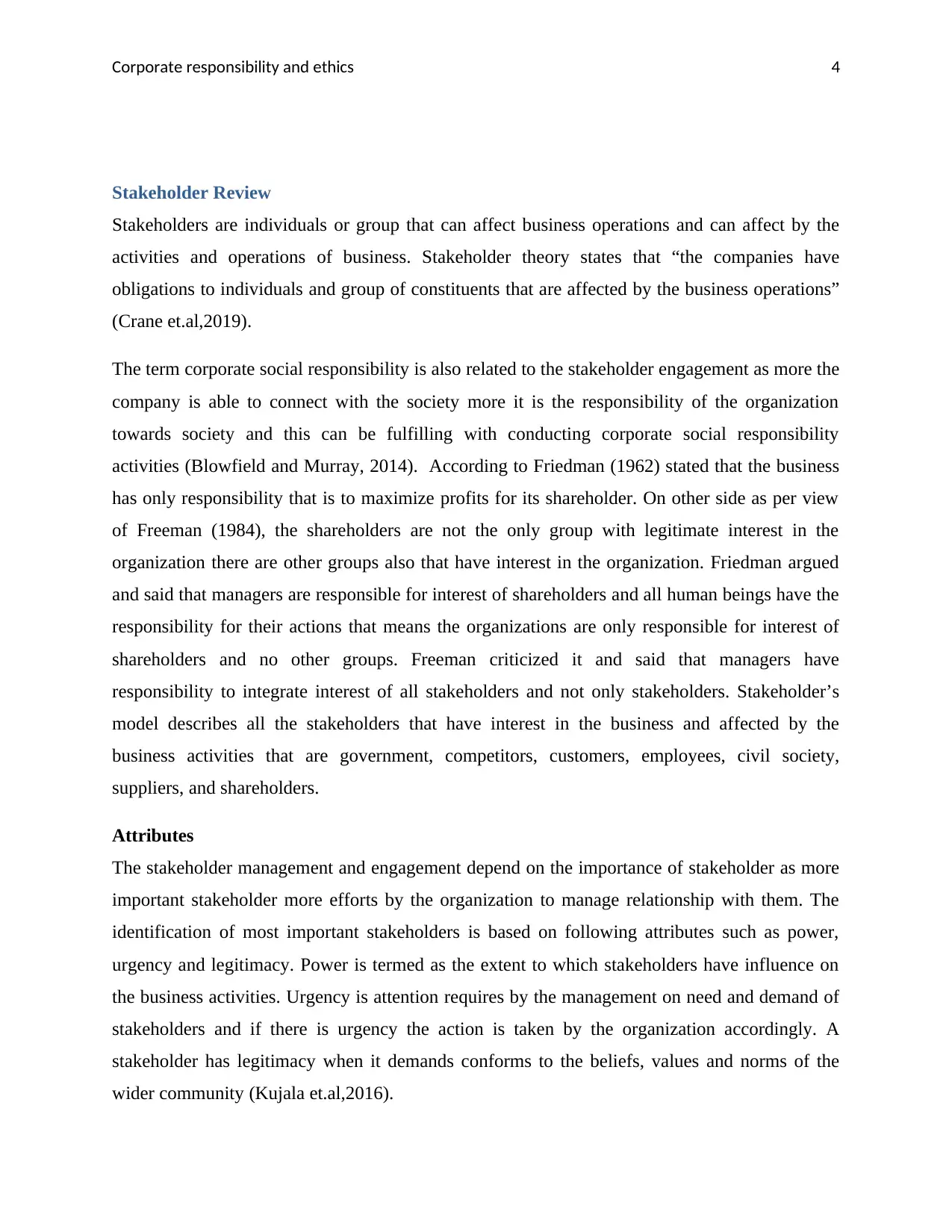
Corporate responsibility and ethics 4
Stakeholder Review
Stakeholders are individuals or group that can affect business operations and can affect by the
activities and operations of business. Stakeholder theory states that “the companies have
obligations to individuals and group of constituents that are affected by the business operations”
(Crane et.al,2019).
The term corporate social responsibility is also related to the stakeholder engagement as more the
company is able to connect with the society more it is the responsibility of the organization
towards society and this can be fulfilling with conducting corporate social responsibility
activities (Blowfield and Murray, 2014). According to Friedman (1962) stated that the business
has only responsibility that is to maximize profits for its shareholder. On other side as per view
of Freeman (1984), the shareholders are not the only group with legitimate interest in the
organization there are other groups also that have interest in the organization. Friedman argued
and said that managers are responsible for interest of shareholders and all human beings have the
responsibility for their actions that means the organizations are only responsible for interest of
shareholders and no other groups. Freeman criticized it and said that managers have
responsibility to integrate interest of all stakeholders and not only stakeholders. Stakeholder’s
model describes all the stakeholders that have interest in the business and affected by the
business activities that are government, competitors, customers, employees, civil society,
suppliers, and shareholders.
Attributes
The stakeholder management and engagement depend on the importance of stakeholder as more
important stakeholder more efforts by the organization to manage relationship with them. The
identification of most important stakeholders is based on following attributes such as power,
urgency and legitimacy. Power is termed as the extent to which stakeholders have influence on
the business activities. Urgency is attention requires by the management on need and demand of
stakeholders and if there is urgency the action is taken by the organization accordingly. A
stakeholder has legitimacy when it demands conforms to the beliefs, values and norms of the
wider community (Kujala et.al,2016).
Stakeholder Review
Stakeholders are individuals or group that can affect business operations and can affect by the
activities and operations of business. Stakeholder theory states that “the companies have
obligations to individuals and group of constituents that are affected by the business operations”
(Crane et.al,2019).
The term corporate social responsibility is also related to the stakeholder engagement as more the
company is able to connect with the society more it is the responsibility of the organization
towards society and this can be fulfilling with conducting corporate social responsibility
activities (Blowfield and Murray, 2014). According to Friedman (1962) stated that the business
has only responsibility that is to maximize profits for its shareholder. On other side as per view
of Freeman (1984), the shareholders are not the only group with legitimate interest in the
organization there are other groups also that have interest in the organization. Friedman argued
and said that managers are responsible for interest of shareholders and all human beings have the
responsibility for their actions that means the organizations are only responsible for interest of
shareholders and no other groups. Freeman criticized it and said that managers have
responsibility to integrate interest of all stakeholders and not only stakeholders. Stakeholder’s
model describes all the stakeholders that have interest in the business and affected by the
business activities that are government, competitors, customers, employees, civil society,
suppliers, and shareholders.
Attributes
The stakeholder management and engagement depend on the importance of stakeholder as more
important stakeholder more efforts by the organization to manage relationship with them. The
identification of most important stakeholders is based on following attributes such as power,
urgency and legitimacy. Power is termed as the extent to which stakeholders have influence on
the business activities. Urgency is attention requires by the management on need and demand of
stakeholders and if there is urgency the action is taken by the organization accordingly. A
stakeholder has legitimacy when it demands conforms to the beliefs, values and norms of the
wider community (Kujala et.al,2016).
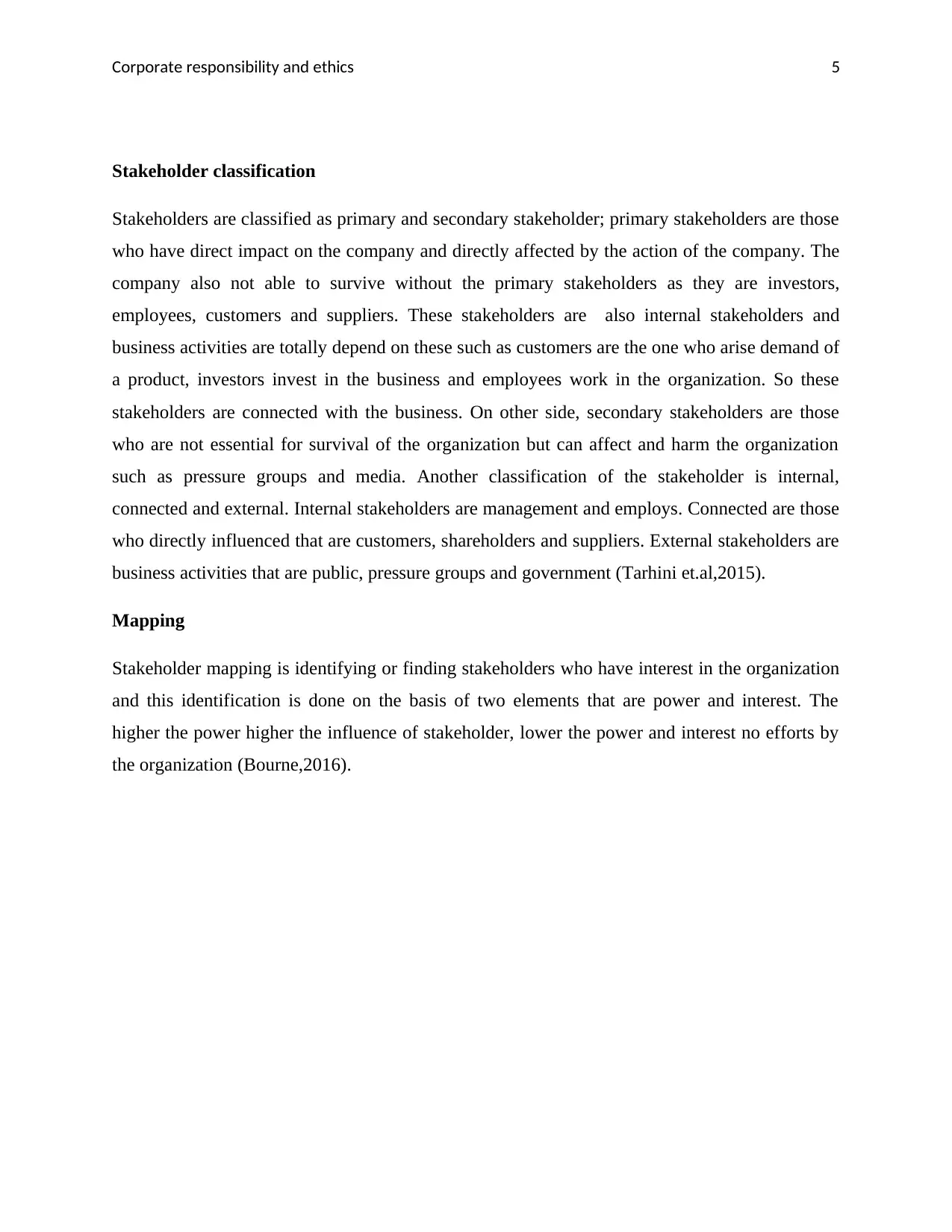
Corporate responsibility and ethics 5
Stakeholder classification
Stakeholders are classified as primary and secondary stakeholder; primary stakeholders are those
who have direct impact on the company and directly affected by the action of the company. The
company also not able to survive without the primary stakeholders as they are investors,
employees, customers and suppliers. These stakeholders are also internal stakeholders and
business activities are totally depend on these such as customers are the one who arise demand of
a product, investors invest in the business and employees work in the organization. So these
stakeholders are connected with the business. On other side, secondary stakeholders are those
who are not essential for survival of the organization but can affect and harm the organization
such as pressure groups and media. Another classification of the stakeholder is internal,
connected and external. Internal stakeholders are management and employs. Connected are those
who directly influenced that are customers, shareholders and suppliers. External stakeholders are
business activities that are public, pressure groups and government (Tarhini et.al,2015).
Mapping
Stakeholder mapping is identifying or finding stakeholders who have interest in the organization
and this identification is done on the basis of two elements that are power and interest. The
higher the power higher the influence of stakeholder, lower the power and interest no efforts by
the organization (Bourne,2016).
Stakeholder classification
Stakeholders are classified as primary and secondary stakeholder; primary stakeholders are those
who have direct impact on the company and directly affected by the action of the company. The
company also not able to survive without the primary stakeholders as they are investors,
employees, customers and suppliers. These stakeholders are also internal stakeholders and
business activities are totally depend on these such as customers are the one who arise demand of
a product, investors invest in the business and employees work in the organization. So these
stakeholders are connected with the business. On other side, secondary stakeholders are those
who are not essential for survival of the organization but can affect and harm the organization
such as pressure groups and media. Another classification of the stakeholder is internal,
connected and external. Internal stakeholders are management and employs. Connected are those
who directly influenced that are customers, shareholders and suppliers. External stakeholders are
business activities that are public, pressure groups and government (Tarhini et.al,2015).
Mapping
Stakeholder mapping is identifying or finding stakeholders who have interest in the organization
and this identification is done on the basis of two elements that are power and interest. The
higher the power higher the influence of stakeholder, lower the power and interest no efforts by
the organization (Bourne,2016).
⊘ This is a preview!⊘
Do you want full access?
Subscribe today to unlock all pages.

Trusted by 1+ million students worldwide
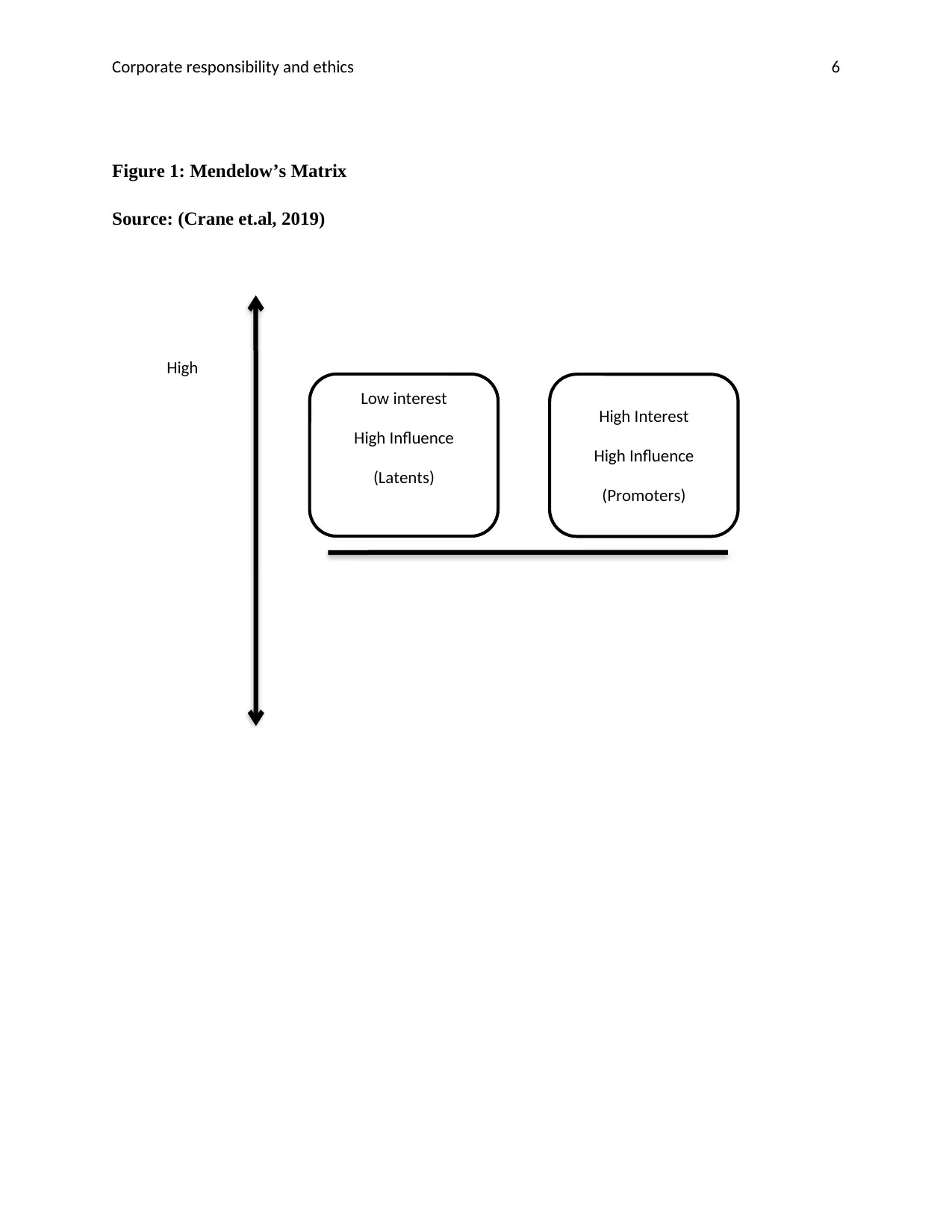
Corporate responsibility and ethics 6
Figure 1: Mendelow’s Matrix
Source: (Crane et.al, 2019)
Low interest
High Influence
(Latents)
High Interest
High Influence
(Promoters)
High
Figure 1: Mendelow’s Matrix
Source: (Crane et.al, 2019)
Low interest
High Influence
(Latents)
High Interest
High Influence
(Promoters)
High
Paraphrase This Document
Need a fresh take? Get an instant paraphrase of this document with our AI Paraphraser
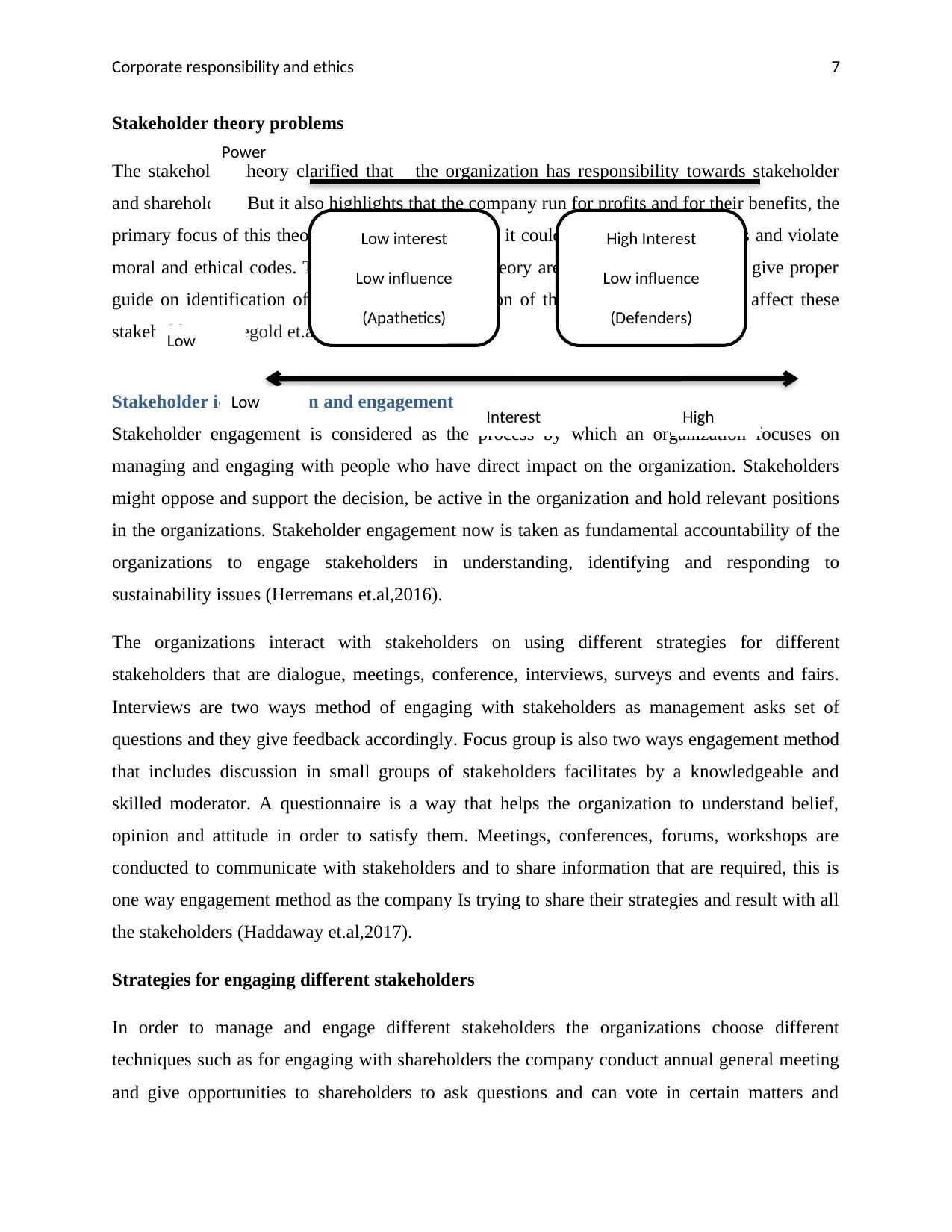
Corporate responsibility and ethics 7
Stakeholder theory problems
The stakeholder theory clarified that the organization has responsibility towards stakeholder
and shareholders. But it also highlights that the company run for profits and for their benefits, the
primary focus of this theory is on shareholders and it could hurt all the stakeholders and violate
moral and ethical codes. The weaknesses of this theory are that the theory does not give proper
guide on identification of shareholders and decision of the organization that most affect these
stakeholders (Finegold et.al, 2011).
Stakeholder identification and engagement
Stakeholder engagement is considered as the process by which an organization focuses on
managing and engaging with people who have direct impact on the organization. Stakeholders
might oppose and support the decision, be active in the organization and hold relevant positions
in the organizations. Stakeholder engagement now is taken as fundamental accountability of the
organizations to engage stakeholders in understanding, identifying and responding to
sustainability issues (Herremans et.al,2016).
The organizations interact with stakeholders on using different strategies for different
stakeholders that are dialogue, meetings, conference, interviews, surveys and events and fairs.
Interviews are two ways method of engaging with stakeholders as management asks set of
questions and they give feedback accordingly. Focus group is also two ways engagement method
that includes discussion in small groups of stakeholders facilitates by a knowledgeable and
skilled moderator. A questionnaire is a way that helps the organization to understand belief,
opinion and attitude in order to satisfy them. Meetings, conferences, forums, workshops are
conducted to communicate with stakeholders and to share information that are required, this is
one way engagement method as the company Is trying to share their strategies and result with all
the stakeholders (Haddaway et.al,2017).
Strategies for engaging different stakeholders
In order to manage and engage different stakeholders the organizations choose different
techniques such as for engaging with shareholders the company conduct annual general meeting
and give opportunities to shareholders to ask questions and can vote in certain matters and
High Interest
Low influence
(Defenders)
Low interest
Low influence
(Apathetics)
Power
Low
Interest
Low High
Stakeholder theory problems
The stakeholder theory clarified that the organization has responsibility towards stakeholder
and shareholders. But it also highlights that the company run for profits and for their benefits, the
primary focus of this theory is on shareholders and it could hurt all the stakeholders and violate
moral and ethical codes. The weaknesses of this theory are that the theory does not give proper
guide on identification of shareholders and decision of the organization that most affect these
stakeholders (Finegold et.al, 2011).
Stakeholder identification and engagement
Stakeholder engagement is considered as the process by which an organization focuses on
managing and engaging with people who have direct impact on the organization. Stakeholders
might oppose and support the decision, be active in the organization and hold relevant positions
in the organizations. Stakeholder engagement now is taken as fundamental accountability of the
organizations to engage stakeholders in understanding, identifying and responding to
sustainability issues (Herremans et.al,2016).
The organizations interact with stakeholders on using different strategies for different
stakeholders that are dialogue, meetings, conference, interviews, surveys and events and fairs.
Interviews are two ways method of engaging with stakeholders as management asks set of
questions and they give feedback accordingly. Focus group is also two ways engagement method
that includes discussion in small groups of stakeholders facilitates by a knowledgeable and
skilled moderator. A questionnaire is a way that helps the organization to understand belief,
opinion and attitude in order to satisfy them. Meetings, conferences, forums, workshops are
conducted to communicate with stakeholders and to share information that are required, this is
one way engagement method as the company Is trying to share their strategies and result with all
the stakeholders (Haddaway et.al,2017).
Strategies for engaging different stakeholders
In order to manage and engage different stakeholders the organizations choose different
techniques such as for engaging with shareholders the company conduct annual general meeting
and give opportunities to shareholders to ask questions and can vote in certain matters and
High Interest
Low influence
(Defenders)
Low interest
Low influence
(Apathetics)
Power
Low
Interest
Low High
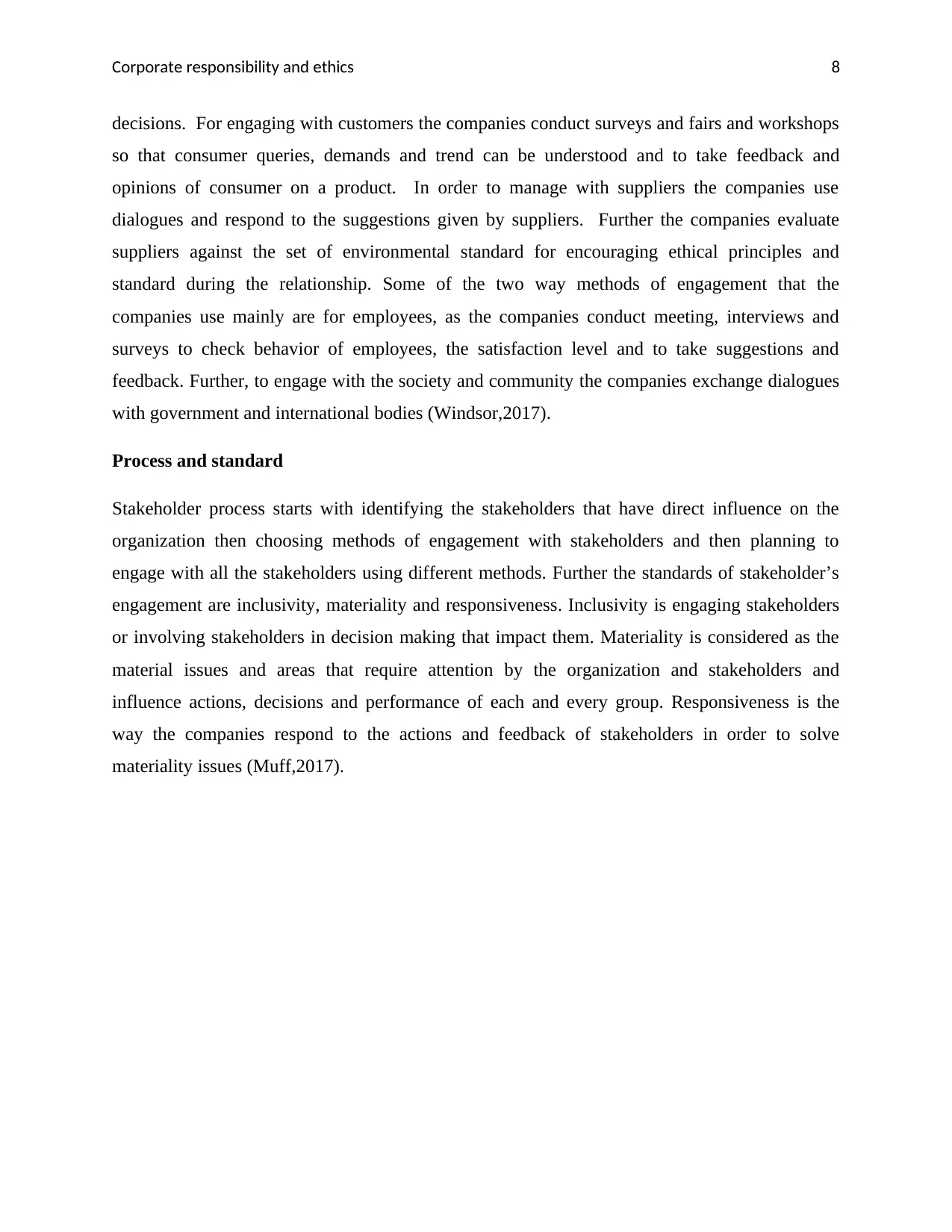
Corporate responsibility and ethics 8
decisions. For engaging with customers the companies conduct surveys and fairs and workshops
so that consumer queries, demands and trend can be understood and to take feedback and
opinions of consumer on a product. In order to manage with suppliers the companies use
dialogues and respond to the suggestions given by suppliers. Further the companies evaluate
suppliers against the set of environmental standard for encouraging ethical principles and
standard during the relationship. Some of the two way methods of engagement that the
companies use mainly are for employees, as the companies conduct meeting, interviews and
surveys to check behavior of employees, the satisfaction level and to take suggestions and
feedback. Further, to engage with the society and community the companies exchange dialogues
with government and international bodies (Windsor,2017).
Process and standard
Stakeholder process starts with identifying the stakeholders that have direct influence on the
organization then choosing methods of engagement with stakeholders and then planning to
engage with all the stakeholders using different methods. Further the standards of stakeholder’s
engagement are inclusivity, materiality and responsiveness. Inclusivity is engaging stakeholders
or involving stakeholders in decision making that impact them. Materiality is considered as the
material issues and areas that require attention by the organization and stakeholders and
influence actions, decisions and performance of each and every group. Responsiveness is the
way the companies respond to the actions and feedback of stakeholders in order to solve
materiality issues (Muff,2017).
decisions. For engaging with customers the companies conduct surveys and fairs and workshops
so that consumer queries, demands and trend can be understood and to take feedback and
opinions of consumer on a product. In order to manage with suppliers the companies use
dialogues and respond to the suggestions given by suppliers. Further the companies evaluate
suppliers against the set of environmental standard for encouraging ethical principles and
standard during the relationship. Some of the two way methods of engagement that the
companies use mainly are for employees, as the companies conduct meeting, interviews and
surveys to check behavior of employees, the satisfaction level and to take suggestions and
feedback. Further, to engage with the society and community the companies exchange dialogues
with government and international bodies (Windsor,2017).
Process and standard
Stakeholder process starts with identifying the stakeholders that have direct influence on the
organization then choosing methods of engagement with stakeholders and then planning to
engage with all the stakeholders using different methods. Further the standards of stakeholder’s
engagement are inclusivity, materiality and responsiveness. Inclusivity is engaging stakeholders
or involving stakeholders in decision making that impact them. Materiality is considered as the
material issues and areas that require attention by the organization and stakeholders and
influence actions, decisions and performance of each and every group. Responsiveness is the
way the companies respond to the actions and feedback of stakeholders in order to solve
materiality issues (Muff,2017).
⊘ This is a preview!⊘
Do you want full access?
Subscribe today to unlock all pages.

Trusted by 1+ million students worldwide
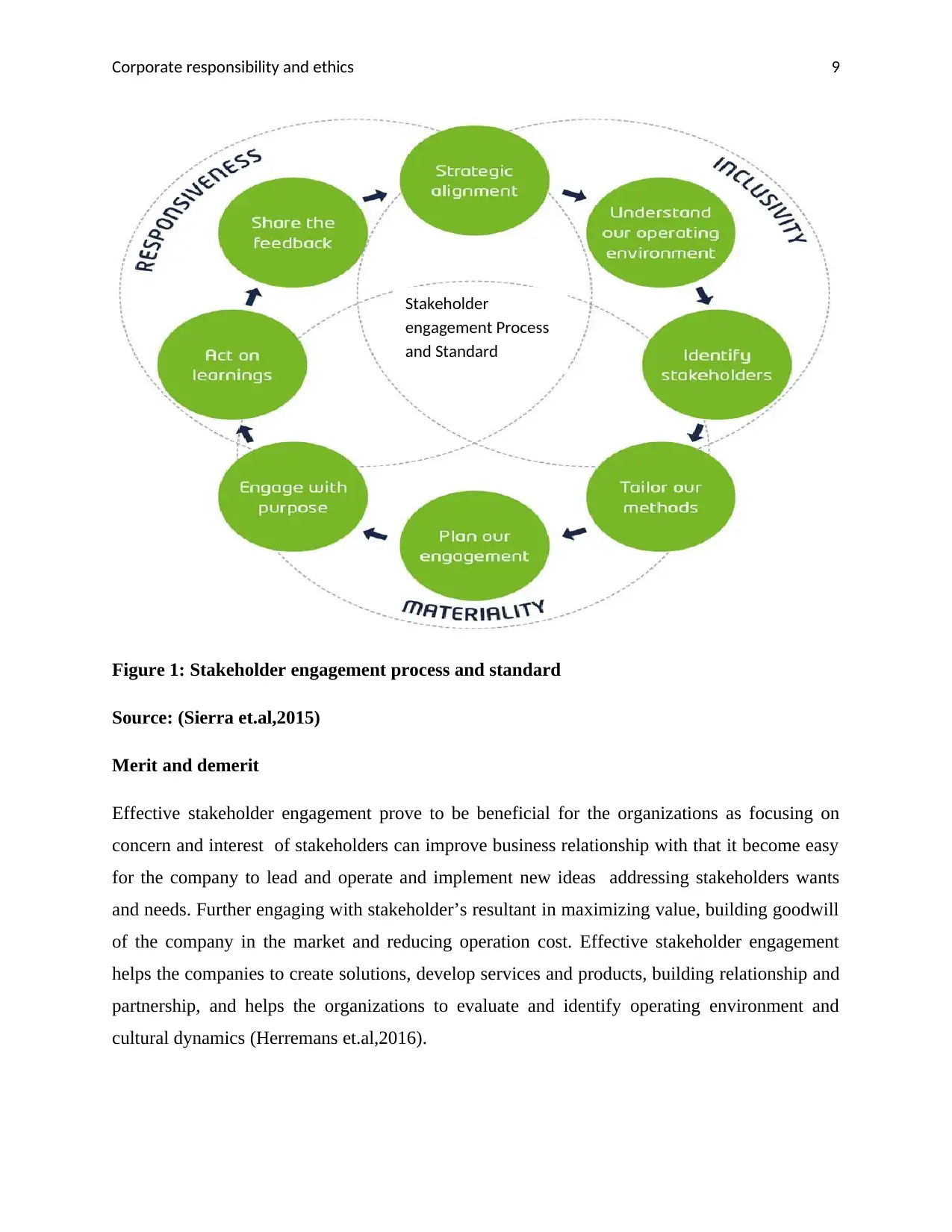
Corporate responsibility and ethics 9
Figure 1: Stakeholder engagement process and standard
Source: (Sierra et.al,2015)
Merit and demerit
Effective stakeholder engagement prove to be beneficial for the organizations as focusing on
concern and interest of stakeholders can improve business relationship with that it become easy
for the company to lead and operate and implement new ideas addressing stakeholders wants
and needs. Further engaging with stakeholder’s resultant in maximizing value, building goodwill
of the company in the market and reducing operation cost. Effective stakeholder engagement
helps the companies to create solutions, develop services and products, building relationship and
partnership, and helps the organizations to evaluate and identify operating environment and
cultural dynamics (Herremans et.al,2016).
Stakeholder
engagement Process
and Standard
Figure 1: Stakeholder engagement process and standard
Source: (Sierra et.al,2015)
Merit and demerit
Effective stakeholder engagement prove to be beneficial for the organizations as focusing on
concern and interest of stakeholders can improve business relationship with that it become easy
for the company to lead and operate and implement new ideas addressing stakeholders wants
and needs. Further engaging with stakeholder’s resultant in maximizing value, building goodwill
of the company in the market and reducing operation cost. Effective stakeholder engagement
helps the companies to create solutions, develop services and products, building relationship and
partnership, and helps the organizations to evaluate and identify operating environment and
cultural dynamics (Herremans et.al,2016).
Stakeholder
engagement Process
and Standard
Paraphrase This Document
Need a fresh take? Get an instant paraphrase of this document with our AI Paraphraser
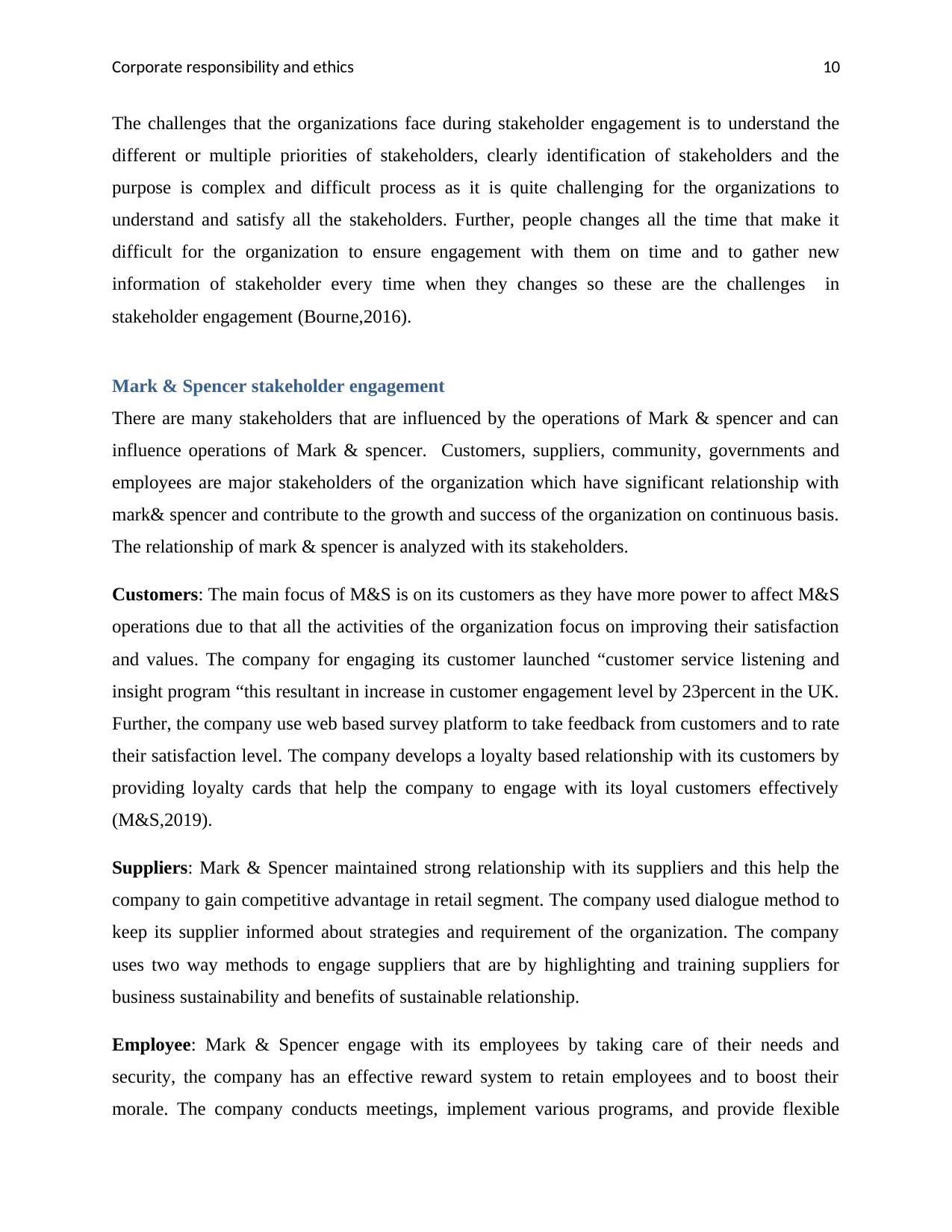
Corporate responsibility and ethics 10
The challenges that the organizations face during stakeholder engagement is to understand the
different or multiple priorities of stakeholders, clearly identification of stakeholders and the
purpose is complex and difficult process as it is quite challenging for the organizations to
understand and satisfy all the stakeholders. Further, people changes all the time that make it
difficult for the organization to ensure engagement with them on time and to gather new
information of stakeholder every time when they changes so these are the challenges in
stakeholder engagement (Bourne,2016).
Mark & Spencer stakeholder engagement
There are many stakeholders that are influenced by the operations of Mark & spencer and can
influence operations of Mark & spencer. Customers, suppliers, community, governments and
employees are major stakeholders of the organization which have significant relationship with
mark& spencer and contribute to the growth and success of the organization on continuous basis.
The relationship of mark & spencer is analyzed with its stakeholders.
Customers: The main focus of M&S is on its customers as they have more power to affect M&S
operations due to that all the activities of the organization focus on improving their satisfaction
and values. The company for engaging its customer launched “customer service listening and
insight program “this resultant in increase in customer engagement level by 23percent in the UK.
Further, the company use web based survey platform to take feedback from customers and to rate
their satisfaction level. The company develops a loyalty based relationship with its customers by
providing loyalty cards that help the company to engage with its loyal customers effectively
(M&S,2019).
Suppliers: Mark & Spencer maintained strong relationship with its suppliers and this help the
company to gain competitive advantage in retail segment. The company used dialogue method to
keep its supplier informed about strategies and requirement of the organization. The company
uses two way methods to engage suppliers that are by highlighting and training suppliers for
business sustainability and benefits of sustainable relationship.
Employee: Mark & Spencer engage with its employees by taking care of their needs and
security, the company has an effective reward system to retain employees and to boost their
morale. The company conducts meetings, implement various programs, and provide flexible
The challenges that the organizations face during stakeholder engagement is to understand the
different or multiple priorities of stakeholders, clearly identification of stakeholders and the
purpose is complex and difficult process as it is quite challenging for the organizations to
understand and satisfy all the stakeholders. Further, people changes all the time that make it
difficult for the organization to ensure engagement with them on time and to gather new
information of stakeholder every time when they changes so these are the challenges in
stakeholder engagement (Bourne,2016).
Mark & Spencer stakeholder engagement
There are many stakeholders that are influenced by the operations of Mark & spencer and can
influence operations of Mark & spencer. Customers, suppliers, community, governments and
employees are major stakeholders of the organization which have significant relationship with
mark& spencer and contribute to the growth and success of the organization on continuous basis.
The relationship of mark & spencer is analyzed with its stakeholders.
Customers: The main focus of M&S is on its customers as they have more power to affect M&S
operations due to that all the activities of the organization focus on improving their satisfaction
and values. The company for engaging its customer launched “customer service listening and
insight program “this resultant in increase in customer engagement level by 23percent in the UK.
Further, the company use web based survey platform to take feedback from customers and to rate
their satisfaction level. The company develops a loyalty based relationship with its customers by
providing loyalty cards that help the company to engage with its loyal customers effectively
(M&S,2019).
Suppliers: Mark & Spencer maintained strong relationship with its suppliers and this help the
company to gain competitive advantage in retail segment. The company used dialogue method to
keep its supplier informed about strategies and requirement of the organization. The company
uses two way methods to engage suppliers that are by highlighting and training suppliers for
business sustainability and benefits of sustainable relationship.
Employee: Mark & Spencer engage with its employees by taking care of their needs and
security, the company has an effective reward system to retain employees and to boost their
morale. The company conducts meetings, implement various programs, and provide flexible
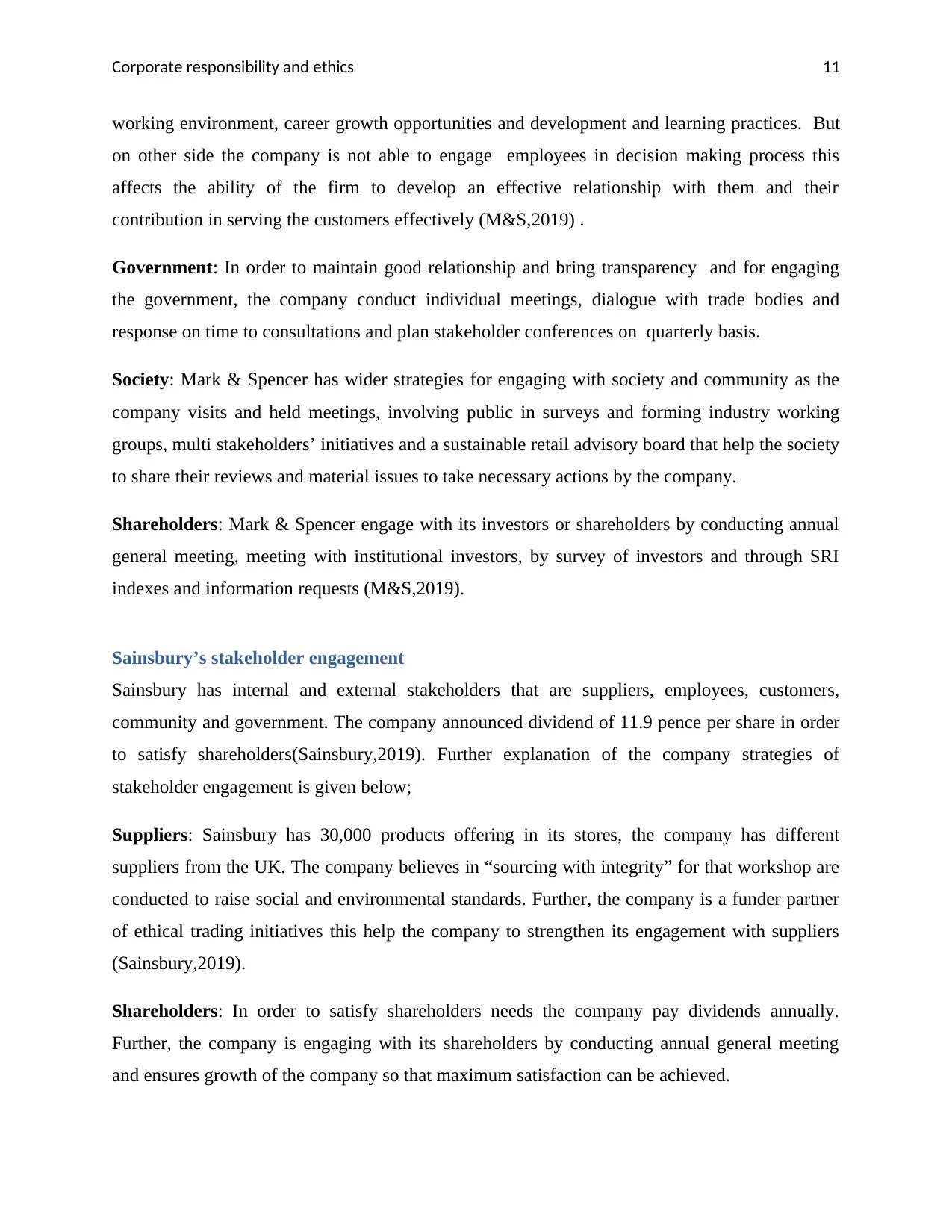
Corporate responsibility and ethics 11
working environment, career growth opportunities and development and learning practices. But
on other side the company is not able to engage employees in decision making process this
affects the ability of the firm to develop an effective relationship with them and their
contribution in serving the customers effectively (M&S,2019) .
Government: In order to maintain good relationship and bring transparency and for engaging
the government, the company conduct individual meetings, dialogue with trade bodies and
response on time to consultations and plan stakeholder conferences on quarterly basis.
Society: Mark & Spencer has wider strategies for engaging with society and community as the
company visits and held meetings, involving public in surveys and forming industry working
groups, multi stakeholders’ initiatives and a sustainable retail advisory board that help the society
to share their reviews and material issues to take necessary actions by the company.
Shareholders: Mark & Spencer engage with its investors or shareholders by conducting annual
general meeting, meeting with institutional investors, by survey of investors and through SRI
indexes and information requests (M&S,2019).
Sainsbury’s stakeholder engagement
Sainsbury has internal and external stakeholders that are suppliers, employees, customers,
community and government. The company announced dividend of 11.9 pence per share in order
to satisfy shareholders(Sainsbury,2019). Further explanation of the company strategies of
stakeholder engagement is given below;
Suppliers: Sainsbury has 30,000 products offering in its stores, the company has different
suppliers from the UK. The company believes in “sourcing with integrity” for that workshop are
conducted to raise social and environmental standards. Further, the company is a funder partner
of ethical trading initiatives this help the company to strengthen its engagement with suppliers
(Sainsbury,2019).
Shareholders: In order to satisfy shareholders needs the company pay dividends annually.
Further, the company is engaging with its shareholders by conducting annual general meeting
and ensures growth of the company so that maximum satisfaction can be achieved.
working environment, career growth opportunities and development and learning practices. But
on other side the company is not able to engage employees in decision making process this
affects the ability of the firm to develop an effective relationship with them and their
contribution in serving the customers effectively (M&S,2019) .
Government: In order to maintain good relationship and bring transparency and for engaging
the government, the company conduct individual meetings, dialogue with trade bodies and
response on time to consultations and plan stakeholder conferences on quarterly basis.
Society: Mark & Spencer has wider strategies for engaging with society and community as the
company visits and held meetings, involving public in surveys and forming industry working
groups, multi stakeholders’ initiatives and a sustainable retail advisory board that help the society
to share their reviews and material issues to take necessary actions by the company.
Shareholders: Mark & Spencer engage with its investors or shareholders by conducting annual
general meeting, meeting with institutional investors, by survey of investors and through SRI
indexes and information requests (M&S,2019).
Sainsbury’s stakeholder engagement
Sainsbury has internal and external stakeholders that are suppliers, employees, customers,
community and government. The company announced dividend of 11.9 pence per share in order
to satisfy shareholders(Sainsbury,2019). Further explanation of the company strategies of
stakeholder engagement is given below;
Suppliers: Sainsbury has 30,000 products offering in its stores, the company has different
suppliers from the UK. The company believes in “sourcing with integrity” for that workshop are
conducted to raise social and environmental standards. Further, the company is a funder partner
of ethical trading initiatives this help the company to strengthen its engagement with suppliers
(Sainsbury,2019).
Shareholders: In order to satisfy shareholders needs the company pay dividends annually.
Further, the company is engaging with its shareholders by conducting annual general meeting
and ensures growth of the company so that maximum satisfaction can be achieved.
⊘ This is a preview!⊘
Do you want full access?
Subscribe today to unlock all pages.

Trusted by 1+ million students worldwide
1 out of 17
Related Documents
Your All-in-One AI-Powered Toolkit for Academic Success.
+13062052269
info@desklib.com
Available 24*7 on WhatsApp / Email
![[object Object]](/_next/static/media/star-bottom.7253800d.svg)
Unlock your academic potential
Copyright © 2020–2025 A2Z Services. All Rights Reserved. Developed and managed by ZUCOL.





